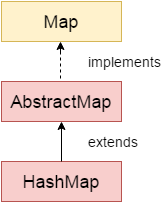Table of Contents
Trong bài này, tôi sẽ giới thiệu với các bạn các đặc điểm của HashMap và các ví dụ cơ bản về sử dụng HashMap trong java. Trong bài viết tiếp theo, chúng ta sẽ tìm hiểu kỹ hơn về cách thức hoạt động bên trong của HashMap trong Java.
1. Đặc điểm
Những điểm quan trọng về lớp HashMap trong java cần nhớ là:
- HashMap lưu trữ dữ liệu dưới dạng cặp key và value.
- HashMap chỉ chứa các key duy nhất.
- HashMap có thể có 1 key là null và nhiều giá trị null.
- HashMap duy trì các phần tử KHÔNG theo thứ tự chèn.
2. Hierarchy của lớp HashMap

Lớp java.util.HashMap được định nghĩa như sau:
public class HashMap<K,V> extends AbstractMap<K,V>
implements Map<K,V>, Cloneable, Serializable {
}
Trong đó:
- K: đây là kiểu key để lưu trữ.
- V: đây là kiểu giá trị được ánh xạ.
3. Các phương thức khởi tạo (constructor) của lớp HashMap
- HashMap(): khởi tạo một map trống.
- HashMap(Map<? extends K, ? extends V> m): khởi tạo một map với các phần tử của map m.
4. Các phương thức (method) của lớp HashMap
Xem thêm các phương thức của Map ở bài viết Map Interface trong java.
5. Ví dụ minh họa
5.1. Ví dụ sử dụng HashMap với kiểu dữ liệu cơ bản (Wrapper)
package com.maixuanviet.collection.map;
import java.util.HashMap;
import java.util.Map;
import java.util.Map.Entry;
public class HashMapExample {
public static void main(String args[]) {
// init map
Map<Integer, String> map = new HashMap<Integer, String>();
map.put(1, "Basic java");
map.put(2, "OOP");
map.put(3, "Collection");
// show map using method keySet()
for (Integer key : map.keySet()) {
String value = map.get(key);
System.out.println(key + " = " + value);
}
System.out.println("---");
// show map using method keySet()
for (Entry<Integer, String> entry : map.entrySet()) {
Integer key = entry.getKey();
String value = entry.getValue();
System.out.println(key + " = " + value);
}
}
}
Kết quả thực thi chương trình trên:
1 = Basic java 2 = OOP 3 = Collection --- 1 = Basic java 2 = OOP 3 = Collection
5.2. Ví dụ sử dụng HashMap với key có kiểu String, value có kiểu Student
package com.maixuanviet.collection.map;
public class Student {
private int id;
private String name;
public Student(int id, String name) {
this.id = id;
this.name = name;
}
@Override
public String toString() {
return "Student [id=" + id + ", name=" + name + "]";
}
public int getId() {
return id;
}
public String getName() {
return name;
}
}
package com.maixuanviet.collection.map;
import java.util.HashMap;
import java.util.Map;
import java.util.Map.Entry;
public class HashMapExample2 {
public static void main(String args[]) {
// Student's data
Student student1 = new Student(1, "Student 1");
Student student2 = new Student(2, "Student 2");
Student student3 = new Student(3, "Student 3");
// init map
Map<Integer, Student> map = new HashMap<Integer, Student>();
map.put(student1.getId(), student1);
map.put(student2.getId(), student2);
map.put(student3.getId(), student3);
// show map using method keySet()
for (Integer key : map.keySet()) {
Student value = map.get(key);
System.out.println(key + " = " + value);
}
System.out.println("---");
// show map using method keySet()
for (Entry<Integer, Student> entry : map.entrySet()) {
Integer key = entry.getKey();
Student value = entry.getValue();
System.out.println(key + " = " + value);
}
}
}
Kết quả thực thi chương trình trên:
1 = Student [id=1, name=Student 1] 2 = Student [id=2, name=Student 2] 3 = Student [id=3, name=Student 3] --- 1 = Student [id=1, name=Student 1] 2 = Student [id=2, name=Student 2] 3 = Student [id=3, name=Student 3]
Related posts:
Array to String Conversions
Spring Boot - OAuth2 with JWT
Hướng dẫn sử dụng luồng vào ra nhị phân trong Java
Setting a Request Timeout for a Spring REST API
Spring Autowiring of Generic Types
Java Program to Implement ScapeGoat Tree
Java Program to Construct an Expression Tree for an Postfix Expression
Creating a Custom Starter with Spring Boot
Spring Data MongoDB Transactions
Upload and Display Excel Files with Spring MVC
How to Convert List to Map in Java
Arrays.asList vs new ArrayList(Arrays.asList())
The Dining Philosophers Problem in Java
Hướng dẫn sử dụng Printing Service trong Java
Java Program to find the maximum subarray sum using Binary Search approach
The Guide to RestTemplate
Java Program to Implement Hamiltonian Cycle Algorithm
Receive email using IMAP
HttpClient 4 – Follow Redirects for POST
A Guide to Java SynchronousQueue
Java Program to Implement Sorted Vector
Hướng dẫn Java Design Pattern – Visitor
Java Program to Implement Jarvis Algorithm
Java Program to Implement Johnson’s Algorithm
DynamoDB in a Spring Boot Application Using Spring Data
Deploy a Spring Boot WAR into a Tomcat Server
Java Program to Perform Addition Operation Using Bitwise Operators
Java 8 – Powerful Comparison with Lambdas
Guide to Java Instrumentation
Guide to DelayQueue
How to Define a Spring Boot Filter?
Java Program to Implement Meldable Heap

